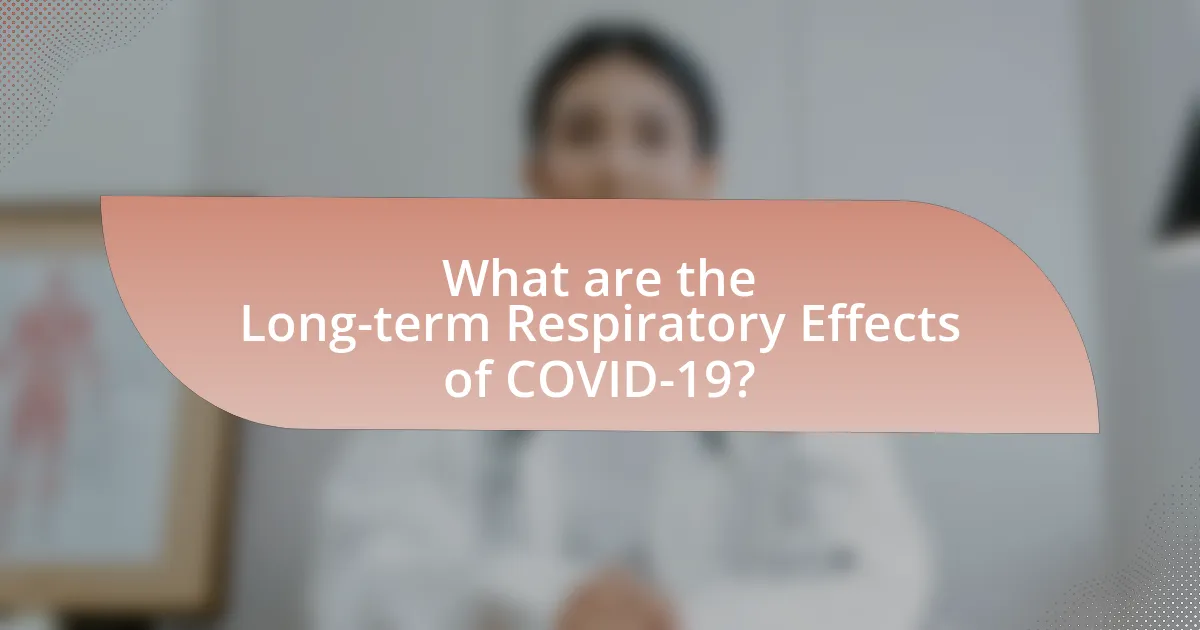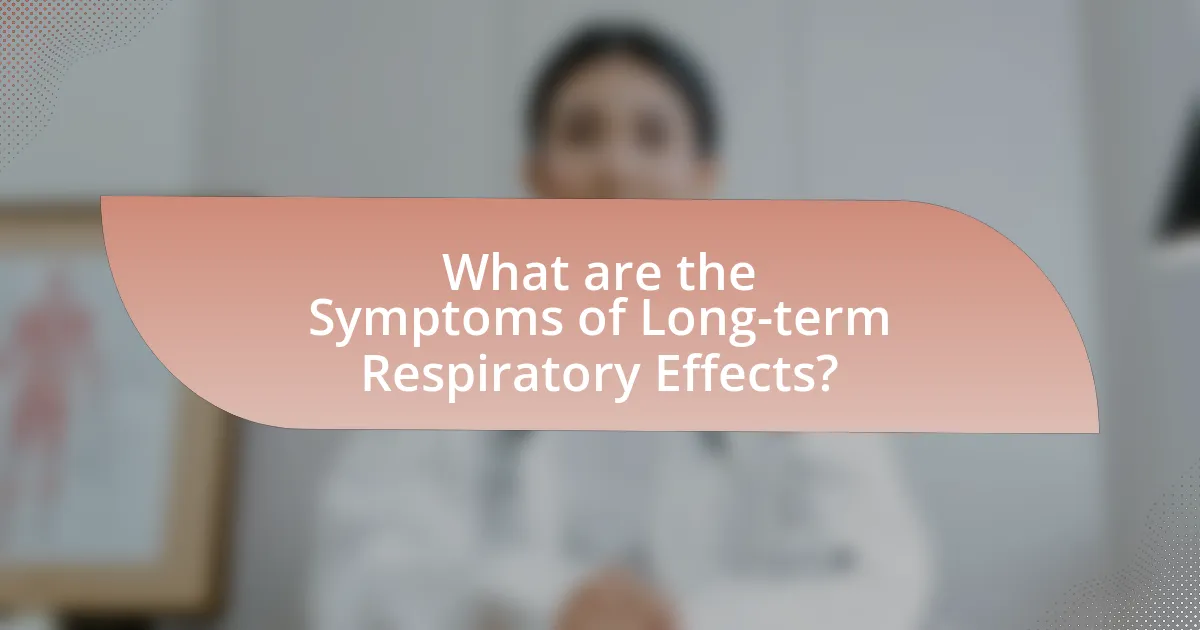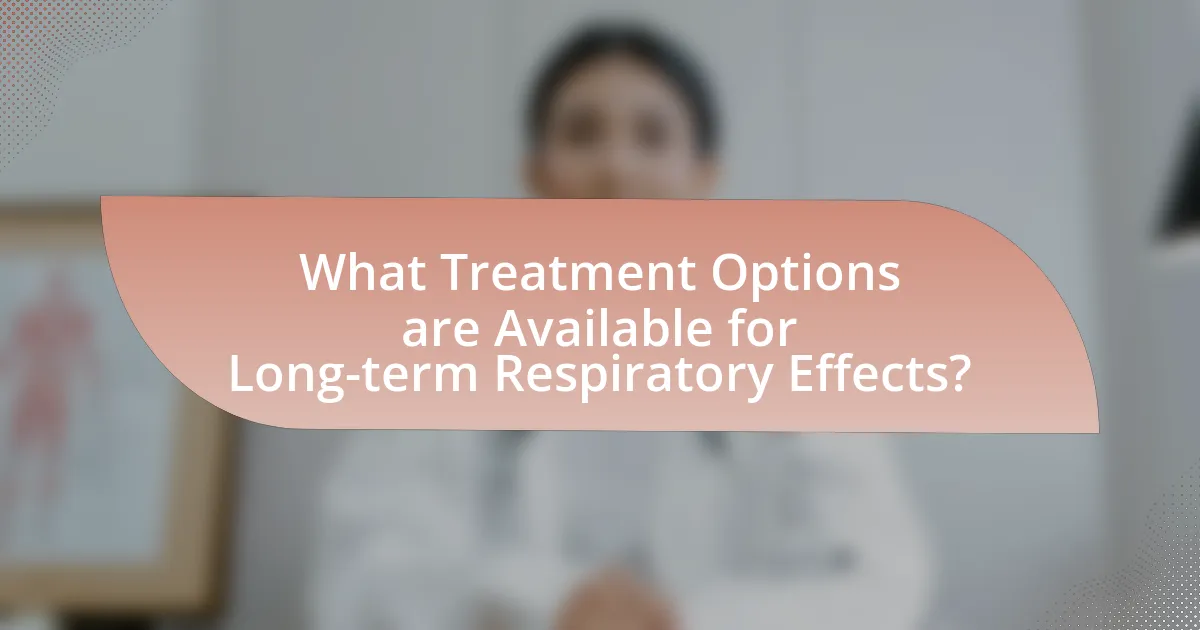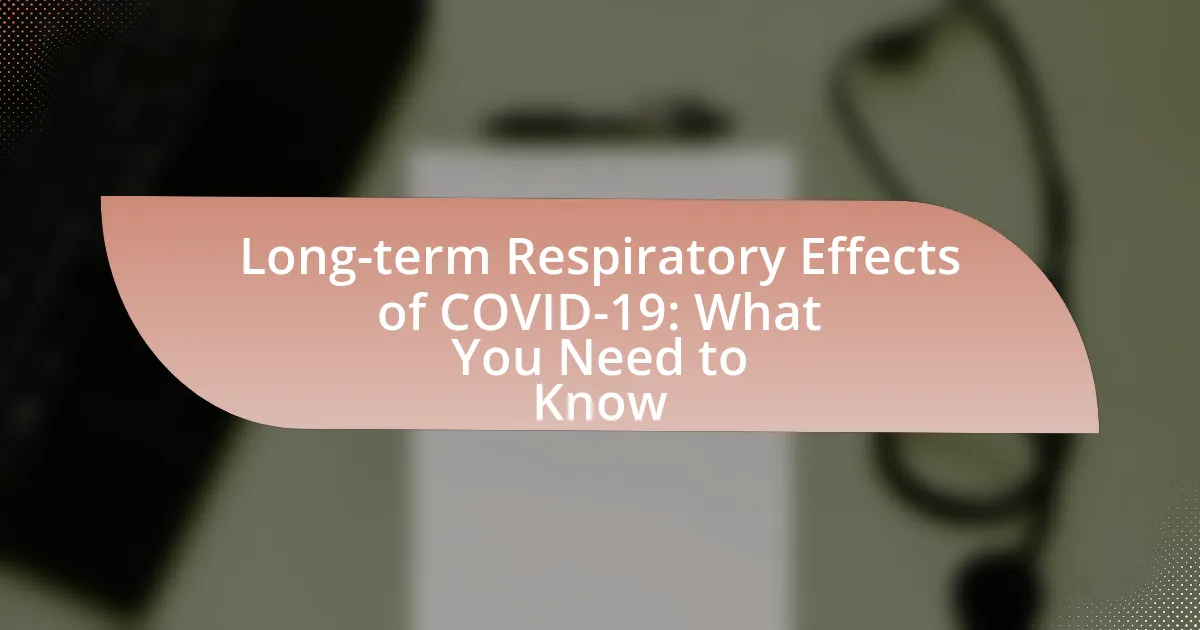The article focuses on the long-term respiratory effects of COVID-19, highlighting persistent symptoms such as cough, shortness of breath, and reduced lung function that affect approximately 30% of survivors. It discusses the potential development of conditions like pulmonary fibrosis and interstitial lung disease, which can lead to ongoing respiratory complications. The article also examines how these effects vary among different populations and emphasizes the importance of understanding these long-term impacts for effective treatment and public health strategies. Additionally, it outlines treatment options, lifestyle changes, and best practices for managing respiratory health post-COVID-19.

What are the Long-term Respiratory Effects of COVID-19?
The long-term respiratory effects of COVID-19 include persistent cough, shortness of breath, and reduced lung function. Studies have shown that approximately 30% of individuals who recover from COVID-19 experience ongoing respiratory symptoms, which can last for months. Research published in the journal “The Lancet” indicates that patients may develop pulmonary fibrosis, a condition characterized by scarring of lung tissue, which can lead to long-term breathing difficulties. Additionally, a study by the National Institutes of Health found that COVID-19 survivors often report decreased exercise capacity and abnormal lung imaging results, further confirming the lasting impact on respiratory health.
How does COVID-19 impact lung function over time?
COVID-19 can lead to long-term impairments in lung function, including reduced lung capacity and persistent respiratory symptoms. Studies have shown that individuals recovering from COVID-19 may experience conditions such as pulmonary fibrosis, which can result in scarring of lung tissue and decreased oxygen exchange efficiency. Research published in the journal “The Lancet Respiratory Medicine” indicates that approximately 30% of patients report ongoing respiratory issues, such as shortness of breath, even months after initial infection. Additionally, a study by the University of California, San Francisco, found that COVID-19 survivors exhibited significant declines in lung function compared to healthy controls, highlighting the potential for lasting damage to respiratory health.
What specific respiratory conditions are associated with long COVID?
Specific respiratory conditions associated with long COVID include chronic cough, dyspnea (shortness of breath), and interstitial lung disease. Research indicates that approximately 30% of individuals recovering from COVID-19 report persistent respiratory symptoms, with chronic cough being one of the most common complaints. Additionally, studies have shown that some patients develop interstitial lung disease, characterized by inflammation and scarring of lung tissue, which can lead to long-term respiratory complications.
How do these conditions vary among different populations?
Long-term respiratory effects of COVID-19 vary significantly among different populations due to factors such as age, pre-existing health conditions, and socioeconomic status. For instance, older adults and individuals with chronic respiratory diseases like asthma or COPD are more likely to experience severe long-term respiratory symptoms, as evidenced by a study published in the journal “Nature Medicine,” which found that 30% of COVID-19 survivors reported persistent respiratory issues, with higher rates in older demographics. Additionally, populations with limited access to healthcare may face exacerbated long-term effects due to delayed treatment and management of symptoms, highlighting disparities in health outcomes across different socioeconomic groups.
Why is it important to understand these long-term effects?
Understanding the long-term respiratory effects of COVID-19 is crucial for developing effective treatment strategies and public health policies. Research indicates that a significant percentage of COVID-19 survivors experience persistent respiratory issues, such as reduced lung function and chronic cough, which can impact their quality of life and overall health. For instance, a study published in the journal “The Lancet” found that 76% of patients discharged from the hospital reported respiratory symptoms three months post-infection. Recognizing these long-term effects enables healthcare providers to tailor rehabilitation programs and allocate resources effectively, ultimately improving patient outcomes and informing future pandemic responses.
What are the implications for public health?
The implications for public health regarding the long-term respiratory effects of COVID-19 include increased healthcare costs, a higher burden on healthcare systems, and the need for ongoing monitoring and treatment of affected individuals. Studies indicate that approximately 10-30% of COVID-19 survivors experience long-term respiratory issues, such as reduced lung function and chronic cough, which can lead to increased hospitalizations and healthcare resource utilization. This necessitates the development of targeted public health strategies to manage these long-term effects, including rehabilitation programs and public awareness campaigns to educate survivors about potential symptoms and the importance of follow-up care.
How can awareness improve patient outcomes?
Awareness can significantly improve patient outcomes by enhancing understanding of long-term respiratory effects of COVID-19. Increased awareness enables patients to recognize symptoms early, seek timely medical intervention, and adhere to treatment plans. For instance, studies indicate that patients who are informed about potential complications, such as chronic cough or reduced lung function, are more likely to engage in preventive measures and follow-up care, leading to better health management. Research published in the Journal of Medical Internet Research highlights that educational interventions can increase patient knowledge and self-efficacy, resulting in improved health behaviors and outcomes.

What are the Symptoms of Long-term Respiratory Effects?
The symptoms of long-term respiratory effects include persistent cough, shortness of breath, and reduced lung function. These symptoms can arise after recovery from COVID-19, affecting daily activities and overall quality of life. Research indicates that approximately 30% of COVID-19 survivors experience respiratory issues months after infection, highlighting the significance of these long-term effects.
What common symptoms do patients experience?
Patients experiencing long-term respiratory effects of COVID-19 commonly report symptoms such as persistent cough, shortness of breath, and chest pain. Research indicates that approximately 30% of individuals recovering from COVID-19 experience these respiratory symptoms, which can last for weeks or even months post-infection. A study published in the journal “The Lancet” by Huang et al. (2021) found that 49% of patients reported respiratory symptoms at follow-up, highlighting the prevalence and impact of these long-term effects on recovery.
How do these symptoms differ from acute COVID-19 symptoms?
Long-term respiratory symptoms differ from acute COVID-19 symptoms primarily in their duration and nature. Acute COVID-19 symptoms typically manifest suddenly and include fever, cough, and shortness of breath, lasting for a few days to weeks. In contrast, long-term respiratory effects, often referred to as “long COVID,” can persist for months and may include chronic cough, fatigue, and difficulty breathing, even after the initial infection has resolved. Research indicates that approximately 10-30% of individuals experience these prolonged symptoms, highlighting a significant difference in the impact and recovery trajectory between acute and long-term respiratory effects of COVID-19.
What are the psychological impacts of these symptoms?
The psychological impacts of long-term respiratory symptoms from COVID-19 include increased anxiety, depression, and post-traumatic stress disorder (PTSD). Research indicates that individuals experiencing persistent respiratory issues often report heightened levels of stress and emotional distress, which can stem from the uncertainty of their health status and the limitations imposed on their daily activities. A study published in the Journal of Affective Disorders found that 30% of COVID-19 survivors experienced significant depressive symptoms, highlighting the mental health burden associated with long-term physical symptoms. Additionally, the chronic nature of respiratory difficulties can lead to feelings of isolation and frustration, further exacerbating mental health challenges.
How can symptoms be monitored and assessed?
Symptoms can be monitored and assessed through regular clinical evaluations, patient-reported outcome measures, and the use of wearable technology. Clinical evaluations involve healthcare professionals conducting physical examinations and reviewing medical history to identify respiratory symptoms such as cough, shortness of breath, and fatigue. Patient-reported outcome measures, such as questionnaires and surveys, allow individuals to self-report their symptoms and track changes over time. Wearable technology, including smartwatches and fitness trackers, can provide continuous monitoring of respiratory rates and oxygen saturation levels, offering real-time data for assessment. Studies have shown that these methods enhance the understanding of long-term respiratory effects in COVID-19 patients, facilitating timely interventions and personalized care.
What tools are available for tracking respiratory health?
Tools available for tracking respiratory health include wearable devices, mobile applications, and spirometry equipment. Wearable devices, such as smartwatches, can monitor heart rate and oxygen saturation levels, providing real-time data on respiratory function. Mobile applications, like MyAir and AsthmaMD, allow users to log symptoms, medication usage, and peak flow readings, facilitating better management of respiratory conditions. Spirometry equipment, used in clinical settings, measures lung function by assessing airflow and volume, which is crucial for diagnosing and monitoring respiratory diseases. These tools collectively enhance the ability to track and manage respiratory health effectively.
How often should patients seek medical evaluation?
Patients should seek medical evaluation at least once every three to six months after recovering from COVID-19, especially if they experience ongoing respiratory symptoms. Research indicates that individuals recovering from COVID-19 may face long-term respiratory effects, necessitating regular assessments to monitor lung function and overall health. A study published in the journal “The Lancet” found that approximately 30% of COVID-19 survivors reported persistent respiratory symptoms, highlighting the importance of follow-up evaluations to address potential complications.

What Treatment Options are Available for Long-term Respiratory Effects?
Treatment options for long-term respiratory effects include pulmonary rehabilitation, inhaled medications, and supplemental oxygen therapy. Pulmonary rehabilitation programs focus on improving lung function and overall physical endurance through exercise training, education, and support. Inhaled medications, such as bronchodilators and corticosteroids, help reduce inflammation and open airways, improving breathing. Supplemental oxygen therapy is utilized for patients with low blood oxygen levels, ensuring adequate oxygen supply for daily activities. These approaches are supported by clinical studies indicating their effectiveness in managing chronic respiratory symptoms post-COVID-19.
What therapies are effective for managing respiratory symptoms?
Effective therapies for managing respiratory symptoms include inhaled corticosteroids, bronchodilators, pulmonary rehabilitation, and supplemental oxygen. Inhaled corticosteroids reduce inflammation in the airways, while bronchodilators help to relax and open the airways, improving airflow. Pulmonary rehabilitation programs combine exercise training, education, and support to enhance physical and emotional well-being in individuals with respiratory issues. Supplemental oxygen therapy is utilized for patients with low blood oxygen levels to ensure adequate oxygenation. Studies have shown that these therapies can significantly improve respiratory function and quality of life in patients experiencing long-term respiratory effects post-COVID-19.
How do pulmonary rehabilitation programs work?
Pulmonary rehabilitation programs work by providing a structured approach to improve the physical and emotional well-being of individuals with chronic respiratory diseases. These programs typically include exercise training, education on lung health, nutritional counseling, and psychological support, all tailored to the patient’s specific needs. Research indicates that participation in pulmonary rehabilitation can lead to significant improvements in exercise capacity, quality of life, and overall health status for patients with conditions such as COPD and post-COVID respiratory issues. For instance, a study published in the journal “Chest” found that patients who completed a pulmonary rehabilitation program experienced a 20% increase in exercise endurance and a notable reduction in symptoms like breathlessness.
What role do medications play in treatment?
Medications play a crucial role in the treatment of long-term respiratory effects of COVID-19 by alleviating symptoms, managing complications, and improving overall lung function. Specifically, medications such as corticosteroids reduce inflammation in the airways, while bronchodilators help open up the air passages, facilitating easier breathing. Clinical studies have shown that corticosteroids can decrease mortality rates in severe COVID-19 cases, highlighting their importance in treatment protocols. Additionally, the use of antiviral medications may help in reducing viral load, thereby potentially mitigating long-term respiratory issues.
How can lifestyle changes support recovery?
Lifestyle changes can significantly support recovery from long-term respiratory effects of COVID-19 by enhancing lung function and overall health. Engaging in regular physical activity, such as aerobic exercises, has been shown to improve respiratory muscle strength and increase lung capacity, which is crucial for individuals recovering from respiratory illnesses. A study published in the journal “Chest” found that patients who participated in structured exercise programs experienced notable improvements in their pulmonary function and quality of life. Additionally, adopting a balanced diet rich in antioxidants, vitamins, and minerals can help reduce inflammation and support immune function, further aiding recovery. Research indicates that a diet high in fruits, vegetables, and omega-3 fatty acids can positively impact lung health and reduce symptoms associated with respiratory conditions. Therefore, implementing these lifestyle changes can play a vital role in the recovery process for individuals experiencing long-term respiratory effects after COVID-19.
What specific exercises are recommended for lung health?
Breathing exercises, aerobic activities, and strength training are recommended for lung health. Breathing exercises, such as diaphragmatic breathing and pursed-lip breathing, enhance lung capacity and efficiency. Aerobic activities like walking, cycling, and swimming improve cardiovascular fitness, which supports lung function. Strength training helps maintain overall muscle strength, which is essential for effective breathing. Research indicates that regular physical activity can improve lung function and reduce respiratory symptoms, particularly in individuals recovering from respiratory illnesses like COVID-19.
How does nutrition impact respiratory recovery?
Nutrition significantly impacts respiratory recovery by providing essential nutrients that support immune function and tissue repair. Adequate intake of vitamins such as A, C, D, and E, along with minerals like zinc and magnesium, has been shown to enhance lung function and reduce inflammation. For instance, a study published in the Journal of Nutrition found that vitamin D deficiency is linked to increased respiratory infections and impaired lung function. Furthermore, a balanced diet rich in antioxidants can help mitigate oxidative stress in the lungs, promoting faster recovery from respiratory illnesses. Thus, proper nutrition is crucial for optimizing respiratory health and recovery post-infection.
What are the best practices for managing long-term respiratory effects of COVID-19?
The best practices for managing long-term respiratory effects of COVID-19 include regular follow-up with healthcare providers, pulmonary rehabilitation, and adherence to prescribed medications. Regular follow-up allows for monitoring of respiratory function and timely interventions. Pulmonary rehabilitation programs, which often include exercise training, education, and support, have been shown to improve lung function and quality of life in patients with post-COVID respiratory issues. Additionally, adherence to medications such as bronchodilators or corticosteroids can help manage symptoms effectively. Studies indicate that these approaches can significantly enhance recovery and mitigate long-term respiratory complications associated with COVID-19.


